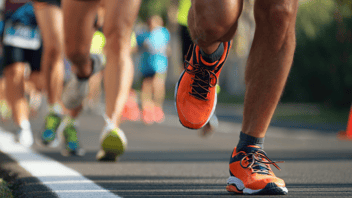Knee pain in runners—it's a story as old as time. While running isn’t inherently bad for your knees, it can be when your running form isn’t optimized. In fact, running can place forces as high as 7.5 times your body weight through the knee joint. Multiply that by thousands of steps across miles, and it's easy to understand how stress-related injuries occur—especially if your body isn’t prepared to manage them.
One of the most common running-related knee injuries is Patellofemoral Pain Syndrome (PFPS), often referred to as runner’s knee. Let’s take a closer look at what it is, how it happens, and what you can do to prevent or recover from it.
What Is Runner’s Knee?
Patellofemoral Pain Syndrome is a condition where the cartilage on the back of your kneecap becomes irritated as it rubs against the thigh bone (femur), particularly under increased compression forces. This irritation can lead to:
-
Aching pain around the front of the knee
-
Tenderness to the kneecap
-
Discomfort during activities like climbing stairs, squatting, or running
PFPS is classified as an overuse injury, meaning it often shows up when you ramp up mileage or intensity too quickly. The knee simply isn’t ready to handle the additional stress.
Are All Mileage Increases Dangerous?
Not at all. The human body is incredibly adaptable and can handle stress well—if given time to adjust.
The key is to listen to your body and increase your training volume gradually. A good rule of thumb is to increase mileage by no more than 5–10% per week. Ignoring early signs of pain and continuing to push through may set you up for longer-term issues like PFPS.
How to Reduce Stress on Your Knees
One of the most effective and often overlooked ways to reduce pressure on your knees is by adjusting your running cadence.
What is Cadence?
Cadence refers to how many steps per minute you take while running. Increasing cadence doesn’t mean running faster—it means taking shorter, quicker steps, which can have a big impact on joint stress.
Why Cadence Matters
When you take shorter steps, your knee doesn’t bend as much. This means your quadriceps don’t have to work as hard with each stride, reducing compression at the patellofemoral joint.
Research shows that even a 7.5% increase in cadence can significantly reduce the forces that contribute to PFPS.
How to Increase Your Cadence
If you've been running at the same cadence for a long time, change might feel awkward at first—but small, intentional shifts can make a big difference. Here are some tips to get started:
-
Use music with a tempo of 160–180 beats per minute
-
Record yourself running on a treadmill to analyze your step rate
-
Focus on taking shorter strides without increasing your pace
-
Train your hip flexors with quick, explosive drills to improve foot turnover
Aim for a cadence in the range of 160–180 steps per minute, depending on your body mechanics and experience level.
What If My Knee Pain Doesn’t Go Away?
If you're struggling with knee pain that won’t go away—or if you're unsure about how to improve your form—it may be time to seek professional help.
At Empower U PT & Performance, our Doctors of Physical Therapy specialize in running analysis and injury prevention. During a 1-on-1 Running Evaluation in Ocean Pines or Rehoboth, we’ll:
-
Perform a full movement and gait assessment
-
Identify underlying causes of your pain
-
Guide you through a custom treatment and form correction plan
Sources
- Saxby DJ, Modenese L, Bryant AL, et al. Tibiofemoral contact forces during walking, running and sidestepping. Gait Posture. 2016;49:78-85. doi:10.1016/j.gaitpost.2016.06.014
- Bump JM, Lewis L. Patellofemoral Syndrome. [Updated 2023 Feb 13]. In: StatPearls [Internet]. Treasure Island (FL): StatPearls Publishing; 2025 Jan-. Available from: https://www.ncbi.nlm.nih.gov/books/NBK557657/
- Heiderscheit BC, Chumanov ES, Michalski MP, Wille CM, Ryan MB. Effects of step rate manipulation on joint mechanics during running. Med Sci Sports Exerc. 2011;43(2):296-302. doi:10.1249/MSS.0b013e3181ebedf4
- Neal BS, Barton CJ, Birn-Jeffrey A, Daley M, Morrissey D. The effects & mechanisms of increasing running step rate: A feasibility study in a mixed-sex group of runners with patellofemoral pain. Phys Ther Sport. 2018;32:244–251. 10.1016/j.ptsp.2018.05.018
Get Back to Running Strong
You don’t have to live with nagging knee pain or fear every time you increase your mileage. With the right strategy and support, you can run pain-free and confidently build toward your goals.
Ready to take the next step?
📅 Book a 1-on-1 Running Evaluation with our team today
Click below to schedule! Offices in Rehoboth & Ocean Pines
📞 410-589-0202



